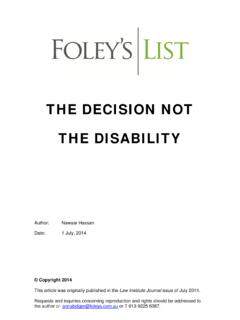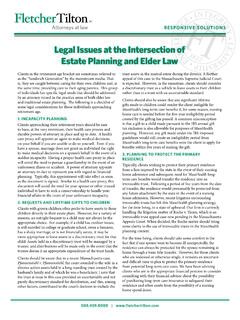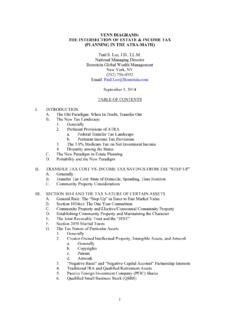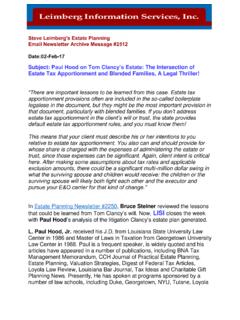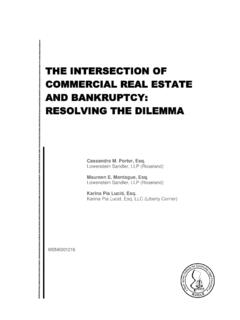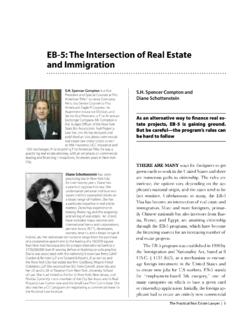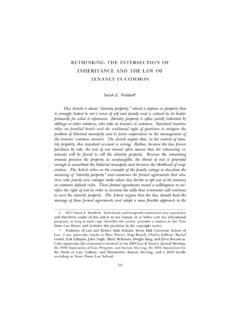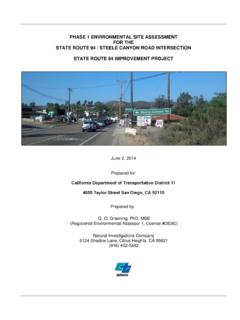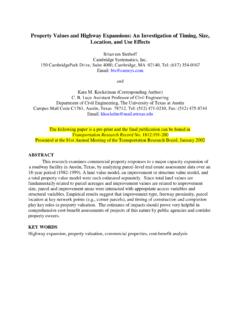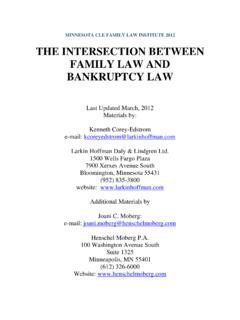Transcription of The intersection of family law and deceased estates
1 THE intersection BETWEEN family LAW AND deceased estates Author: Lachlan Wraith Date: 30 October, 2015 Copyright 2015 This work is copyright. Apart from any permitted use under the Copyright Act 1968, no part may be reproduced or copied in any form without the permission of the Author. Requests and inquiries concerning reproduction and rights should be addressed to the author c/- or T 613-9225 6387. 1 The intersection between family Law and deceased estates Lachlan Wraith Barrister, Victorian Bar Jarndyce Chambers 2 INTRODUCTION We live in a community with an aging population in which there is an increasing tendency for people to enter into second or subsequent marriages, or long term domestic relationships.
2 This necessarily leads to complications around the blending of families and potential conflicts of personalities and financial interests. In addition the longevity afforded by advances in medical science is leading to prolonged periods of life with dementia. The law is grappling with issues surrounding family asset control and division in the context of relationship breakdown, death and incapacity on an ever increasing basis. In addition to base financial motivations and underlying interpersonal conflict between key players, there is an added dimension created by the potentially profound impact grief can make on people s capacity to make reasonable decisions.
3 It is in this context that streams of law with quite distinct origins and approaches meet and interact, often in circumstances of high emotion and deep conflict. The interaction of these areas of law can create unexpected outcomes and it is important for advisors and litigators in any of these areas to be conversant with the key issues across other areas. Relevant areas include: 1. The law relating to incapacity (guardianship and administration, enduring powers of attorney and litigation guardians). 2. family law maintenance and property division (including binding financial agreements).
4 3. Property law /joint tenancies / abatement / constructive trusts. 4. Discretionary ( family ) trusts. 5. Superannuation. 6. Wills and estate planning. 7. estate administration. 8. Testator family maintenance applications. 3 Generally the advisor wishes to assist his or her client in determining the management and/or allocation of the client s wealth in the event of death, incapacity and/or marital breakdown, in accordance with the client's wishes, with minimum prospect of interference by courts, in the most tax effective way.
5 Generally the litigator wishes to advance the client's objective of either upholding or challenging an estate plan, or to the extent there is none, furthering the client s perspective of appropriate management or allocation of the wealth of a deceased or incapacitated person. The topics thrown up by the confluence of laws in this area are potentially boundless. This paper is intended to canvas of some of the issues that have come to the fore in cases that have crossed my desk in in recent times.
6 It is by no means comprehensive and deals largely with issues around property division following death of a party to relationship under the family Law Act and the Administration and Probate Act. Inherently it deals with the position under Victorian law. The paper is not intended to be a detailed and comprehensive discussion of all relevant issues (that would take a book). It is intended to raise awareness in practitioners in each jurisdiction (wills and estates , and family law) of the approach adopted in the other to common issues, and to raise awareness of the individual issues that arise in the different areas of practice.
7 I begin with a table setting out in summary form some of the key issues, and then discuss their practical application in the context of a hypothetical, the case of Jack and Jill. 4 Table of Key Issues: Issue family law Trust & estate law Approach to property division between spouses A discretionary judgement based on an assessment of the history of the relationship with weight given to financial and non-financial (homemaker) contributions, potentially with an adjustment based on an assessment of the parties competing future needs.
8 The process involves a discretionary evaluation of the weight to be attached to each relevant fact found to be proven, and the determination of a just and equitable outcome. In claims for further provision from an estate brought by a surviving spouse similar discretionary considerations apply although arguably there is a greater focus on future needs with the yardstick of provision of a home, income, and a capital sum for future contingencies being a reference point where an estate is of a sufficient size to accommodate the claim.
9 Property proceedings after the death of one spouse The powers of the court cut both ways: in theory the court can order the estate to transfer assets to the surviving spouse, or the surviving spouse to transfer assets to the estate . It is a one-way street: the property of the surviving spouse is not available to satisfy claims of the estate . Relevance of the needs of third parties In properly proceedings between a surviving spouse and a deceased spouse s estate the strength of the moral claims of third parties to share in the bounty of the deceased are largely ignored Flanagan v Sobek [2014] FamCA 696 [11] (although the claims of third-party creditors can be relevant to determining the assets available for division between the parties to the relationship).
10 In proceedings for further provision from an estate the claims of a plaintiff spouse are weighed-up having regard to the claims of other persons (including the deceased 's children). However, in many cases the claim of the surviving spouse may be viewed as taking precedence over other claims. Treatment of superannuation There is a specific part of the family Law Act (Part VIII B) dealing with the court s power to make orders with respect to a party's interest in superannuation. Unless trustees resolve to pay a members death benefit (including any insurance component) to an estate , superannuation proceeds are beyond the reach of the court in a family Provision Claim.


